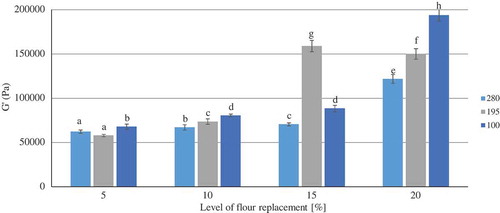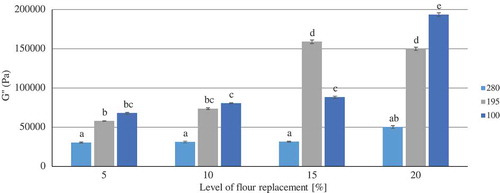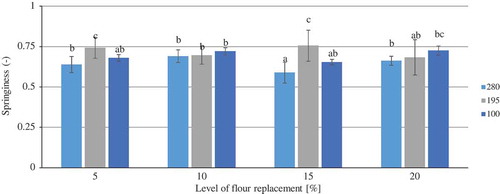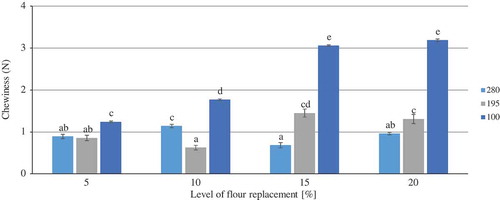Abstract
The effects of β-glucan particle size and the ratios of β-glucan to flour on the physicochemical properties of wheat rolls were examined. A total of 100, 195 and 280 µm particles were analyzed with flour replacement from 0% to 20%. Wheat rolls made with the various particles and flour replacement levels were measured for rheology, yield and volume, texture, color, porosity, total dietary fiber (TDF) content and β-glucan content. All products had a smaller volume compared to the control, whereas the lightness was not significantly affected. Texture analysis indicated that the most favorable textural values were observed for the formulation involving the 195 μm β-glucan particles. Rolls with the same flour replacement level using the smaller particles had a higher share of TDF due to the greater surface of water evaporation. The main finding from the research was that the best results in most measured parameters were observed using 195 µm dietary fiber preparation. Thus, particle size reduction might be used to improve product properties but only to a certain extent because the load of micronized fiber weakens the structure, resulting in decreased product quality.
Se examinaron los efectos del tamaño de la partícula β-glucano y las proporciones de β-glucano en la harina para las propiedades fisicoquímicas de los panecitos de trigo. Se analizaron 100, 195 y 280 µm de partículas con sustitución de harina del 0% al 20%. A los panecitos de trigo elaborados con diversas partículas y niveles de sustitución de harina se les examinaron la reología, el rendimiento, el volumen, la textura, el color, la porosidad, el contenido total de fibra alimentaria (TDF) y el contenido en β-glucano. Todos los productos obtuvieron un menor volumen en comparación con los productos control, mientras que la ligereza no se vio afectada de forma significativa. El análisis de la textura indicó que los valores texturales más favorables se observaron en la formulación que contenía 195 μm de partículas β-glucano. Los panecitos con el mismo nivel de sustitución de harina con el uso de partículas más pequeñas resultaron tener una mayor parte de TDF debido a una superficie más grande de evaporación de agua. El principal hallazgo de este estudio fue que los mejores resultados en la mayoría de parámetros examinados se observaron utilizando 195µm de preparación de fibra alimentaria. De este modo, la reducción del tamaño de las partículas podría ser utilizada para mejorar las propiedades del producto pero únicamente hasta cierto punto, debido a que la carga de fibra micronizada debilita la estructura y resulta en una reducción de la calidad del producto.
Palabras clave:
Introduction
β-glucans are a class of soluble fibers linked to several health benefits (El Khoury, Cuda, Luhovyy, & Anderson, Citation2012). These fibers are becoming significantly more popular as an ingredient in baking industries (Goldstein, Ashrafi, & Seetharaman, Citation2010). β-glucan is a non-starch polysaccharide and one of the structural components of the cell wall of grains (e.g., oats and barley) and yeast. β-glucan consists of D-glucose monomers linked by β-glycosidic bonds. The water-soluble isomer with (1,3/1,4) bonds, found in bran, wholegrain oats and barley, is the most nutritionally active (Ahmed, Citation2015). Consequently, the highest glucan contents among cereals have been found in barley (2.5–11.3%) and oat (2.2–7.8%), followed by rye (1.2–2.9%) and wheat (0.4–1.4%). (http://www.sciencedirect.com/science/article/pii/S0144861714008510#). This is as well β-glucan from fungal sources with 1,3/1,6 bonds. Despite its health benefits, it is hardly used as a bioactive substance in real foods (Du, Lin, Bian, & Xu, Citation2015).
Consuming food fortified with β-glucan may have a positive health influence. β-glucan decreases low density cholesterol (LDL) levels, leading to a reduced risk of coronary heart disease and hypertension (Chen & Raymond, Citation2008). Additionally, β-glucan creates a viscous layer on the surface of intestinal villi, which might lead to reduced absorption of cholesterol and bile acids (Butt, Tahir-Nadeem, Khan, Shabir, & Butt, Citation2008). Furthermore, the increased intestinal lumen viscosity due to β-glucan leads to positive hypoglycemic effects (Panahi et al., Citation2014). β-glucan also affects the brain satiety center, which might lead to the use of β-glucan in fighting obesity.
The use of β-glucan in the production of bakery goods is technologically justified as it delays the processes of retrogradation and syneresis in baked products. β-glucan is the carbohydrate that could form the hydrocolloid structure during bread production. Decreased water secretion from carbohydrate structures (such as β-glucan hydrocolloid structure) results in increased moisture and softness of bakery goods over time (Fik & Surówka, Citation2002). β-glucan may also play an important role by stabilizing air bubbles and preventing them from joining together (Moschakis, Lazaridou, & Biliaderis, Citation2014). Moreover, β-glucan structures are resistant to irridation, thereby making them more usable in various matrices (Shah et al., Citation2015).
Current regulations, including the EU Directive number 432/2012, permit the following health claim to be placed on products: ‘Oat β-glucan has been shown to lower/reduce blood cholesterol. High cholesterol is a risk factor in the development of coronary heart disease’ (EFSA, Citation2011).
The health benefits of oat β-glucan may vary depending on the preparation methods or β-glucan particle size and molecular weight (Sibakov et al., Citation2011). Reduced particle sizes can be effectively achieved by the mechanical treatment of polysaccharide raw materials. Several milling devices have been studied for this purpose (Niemi et al., Citation2012). However, the effect of varying β-glucan particle sizes on the physicochemical properties of bakery products is unclear. Therefore, the aim of this study is to evaluate the effect of particle size and level of wheat flour replacement on the physicochemical properties of wheat rolls to determine whether it is possible to fortify the rolls with more β-glucan when the particle size is decreased.
Materials and methods
Flour
Commercial wheat flour consisted of 10.97% proteins, 0.51% ash and 28.6% gluten with a 14.04% moisture content (Polskie Mlyny, Inc., Poland). The flour composition was measured with near-infrared spectroscopy (NIRFlex N-500, Buchi, Switzerland).
Dietary fibers
The fiber preparation consisted of 44 g/100 g of dietary fiber (23 g soluble and 21 g insoluble fractions). The entire preparation consisted of concentrated 16 g/100 g of β-glucan (Microstructure Inc., Poland). The β-glucan from the supplier was used as the maximum particle size. 0.5 mm and 0.2 mm screens in the ZM 200 rotor mill (Retsch, Germany) were used to produce two smaller particles. Static image analysis (Morphology G3SE, Malvern Instrument Ltd, Malvern, England) was performed to estimate the mean particle sizes at 280 µm, 195 µm and 100 µm.
Preparation of bread rolls
Constituents of the rolls are presented in . The water content was adjusted to achieve 500 Brabender Units. The control sample was prepared without β-glucan. All constituents apart from fat were mixed with the TRQ – 42, RM Spiral mixer (Gastro, Poland) at 200 rpm for 4 min. The fat was then added and the dough was mixed for an additional 6 min prior to a 15 min resting period. The dough was divided and formed into 60 g rolls. The proofing time was 60 min (35°C, 85% relative humidity). Bread rolls were baked at 180°C for 14 min in the CPE 110 convection oven (Kuppersbuch, Germany) and cooled at room temperature.
Table 1. Constituents of bread used in the study with different flour replacement levels with β-glucan preparation. The water content was adjusted to achieve 500 BU.
Tabla 1. Constituyentes del pan utilizado en este estudio con diferentes niveles de sustitución de harina con preparación de β-glucano. El contenido de agua se ajustó para conseguir 500 BU.
Rheology
Rheological measurements were conducted with the Haake RT 20 rheometer (Haake, Germany) on a 2 g piece of dough without the addition of yeast to prevent the formation of gas bubbles. A forced oscillation test was conducted in the plate–plate geometry with a 2 mm gap. Upon the determination of the viscoelastic region, the following measurement parameters were selected: frequency of oscillation was 1 Hz, shear stress was 600 Pa, sensor angle rotation was 2°C and the temperature during measurements was 15°C. Measurements of G’ – Pa (storage modulus) and G” – Pa (loss modulus) were conducted in triplicate.
Yield and volume
The dough and bread rolls (1 h after baking) were weighed and the production yield was calculated as a mass of the final product after cooling for 100 g of flour-β-glucan preparation. The volume of baked bread rolls during storage was determined according to the rapeseed displacement method.
Texture
The texture profile of the rolls in a double compression cycle was recorded with the Instron 5965 Universal Testing Machine (Instron, USA) with the maximal load of 500 N, 50% penetration depth using a 40-mm-diameter probe and a 20 s gap between compressions on 20 mm × 20 mm × 20 mm crumb cubes. The application conditions of the texture profile analysis were: pretest speed of 2 mm/s, test speed of 5 mm/s and post-test speed of 5 mm/s. The parameters analyzed were firmness (the peak force during first bite; N), cohesiveness (area 2/area 1; -), springiness (the ratio between the recovered height after the first compression and the original sample height) and chewiness (firmness x cohesiveness x springiness; N). The measurements were taken 24 h after baking.
Color
The Minolta CR-400 colorimeter (Konica Minolta Inc., Japan) was used to determine rolls’ crumb color 3 h after baking (illuminant D65, measurement area ø = 8 mm, standard observers 2°) and the results were expressed according to the CIELab color space. Measured parameters were L (L = 0/black and L = 100/white), a (–a = greenness and +a = redness) and b (–b = blueness and +b = yellowness). Three different rolls were analyzed a total of 10 times.
Crumb porosity
Computer image analysis of TIFF images was used to estimate porosity. The loaf was cut into 2.5-cm-thick slices. The slices were digitally photographed using lightening from lamps with the color temperature at 5400 K. Images were analyzed using ImageJ (Wayne Rasband, National Institutes of Health, USA). The central image of the crumb was selected and the area was calculated. This was then converted into an 8-bit image to obtain a black and white threshold before performing binary segmentation. The results are presented as the percentage of pore area in the total area.
Microscopy
The pieces of wheat bread rolls (0.5 cm cubes) were taken from the crumb. Then, 1% of agar solution was used for embedding, followed by 1% glutaraldehyde in 0.1 mol/l phosphate buffer, pH 7.0, dehydrated with ethanol and hardened in the Historesin (Leica, Heidelberg) solution overnight. Then, the 4 µm parts were sectioned. For the fluorescence microscopic examination, the bread sections were stained with Fuchsin acid (0.1% w/v) and 0.01% (w/v) Calcofluor (Fluorescent brightener 28, Aldrich, Germany). Calcofluor stains intact cell walls blue. Fuchsin acid stains proteins red. Starch remains unstained and appears black (Maeda et al., Citation2015).
TDF and β-glucan content
TDF in baked bread rolls was measured according to the AOAC 2009.01 method with the FOSS Fibertec E 1023 system (FOSS Inc., USA). β-glucan content was measured with the β-glucan Assay Kit (Mixed Linkage), according to the manufacturer’s instructions (Megazyme, Bray, Ireland).
Statistics
The results are presented as the mean value ± standard deviation. To calculate p-values, the one-way analysis of variance followed by Tukey’s test and the Pearson correlation matrix were performed using Statistica 10 for Windows (StatSoft Inc., USA). P ≤ 0.05 was considered significant.
Results and discussion
Rheological parameters
The storage modulus G’ (Pa) and loss modulus G” (Pa) were calculated to determine the effect of the fiber particle diameter on rolls’ rheology. As the β-glucan fiber content increases with the replacement of flour, the storage modulus G’ also increases ( and ). This result is consistent with the observations of Skendi, Biliaderis, Papageorgiou, and Izydorczyk (Citation2010), where the addition of β-glucan in the dough increases the G’ values in quality flour. The fortification of β-glucan in the dough increases the deformation resistance, elasticity and flowability. The higher G’ values than G” indicate that the dough is more elastic than viscous. This could be caused by an interaction between the dietary fiber and gluten or other dough constituents, resulting in increased levels of high mass molecules (Sivam, Sun-Waterhouse, Waterhouse, Quek, & Perera, Citation2011). Both G’ and G” values were similar to the control (data not shown) when the 195 µm β-glucan particle was used.
Yield and volume
There are significant (p ≤ 0.05) changes in the yield and volume of rolls made with β-glucan of varying particle sizes (). The volume increases in all β-glucan-added dough compared to the control with the same result when increasing the β-glucan:flour ratio. In addition, total β-glucan levels affect flour quality and rolls volume. The final rolls volume is also determined by the β-glucan molecular weight and particle size. For low-quality flour, β-glucan supplementation improves the properties of the bread, whereas a larger particle size decreases the resulting bread quality (Iranshahi, Mahdi, Ardebili, & Yasini, Citation2014).
Table 2. The psychicochemical properties of wheat rolls fortified with β-glucan preparation.
Tabla 2. Las propiedades fisicoquímicas de los panecitos de trigo enriquecidos con β-glucano.
The particle size of fibers mixed in dough can impact the volume of bread, causing physical disruptions to the produced bread (Majzoobi, Farahnaky, Nematolahi, & Hashemi, Citation2013). The influence of particle size and its distribution in the dough is significant. There is a lower volume for bread productions with the increase of dietary fibers added. Replacing flour with fiber particles disrupts the homogeneity and continuity of the protein strands. Thus, there is a decrease in the gluten strength and dilution in the gluten content, thereby interfering with the optimal formation of the gluten matrix during the fermentation of the dough and in bread-making, making the dough less capable of holding gas (Choi, Kang, Cheong, Hyun, & Kim, Citation2012).
Texture analysis
The firmness was greatest in the rolls samples with the smallest β-glucan particles added in the highest amount (). It was predicted that the firmness would be higher in the samples with smaller particle sizes due to the increased entrenchment in the gluten network. The results are consistent with those of previous studies, where the β-glucan polymer size has an effect on the firmness of the bread, with larger particles producing less-firm bread (Skendi, Biliaderis, et al., Citation2010). Conversely, cohesiveness measurements indicated that it was influenced both by the particle size and by the level of flour replacement (). The increase in cohesiveness reflects a decreasing tendency of the bread to fracture and crumble (Ho, Abdul Aziz, Bhat, & Azahari, Citation2014). Springiness is often defined as the elasticity of the crumb. Springiness was the highest in the breads composed of medium β-glucan particles and was not significantly influenced by the level of flour replacement (). Crumb chewiness is a product of crumb firmness, cohesiveness and springiness and was the highest for the breads with the smallest β-glucan particles ().
Figure 3. Firmness (N) of wheat rolls fortified with β-glucan.
Figura 3. Firmeza (N) de los panecitos de trigo enriquecidos con β-glucano.
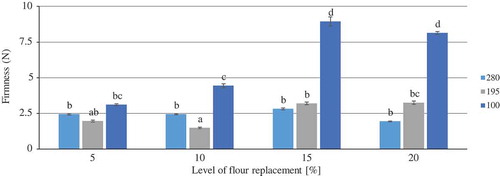
Figure 4. Cohesiveness of wheat rolls fortified with β-glucan.
Figura 4. Cohesión de los panecitos de trigo enriquecidos con β-glucano.

Color parameters
The mixture of flour and β-glucan resulted in significant changes in color from the control (). The addition of β-glucan reduced the L* (lightness) of rolls, similar to the study carried out by Skendi, Papageorgiou, & Biliaderis (Citation2010), where the dough was darker and coarser after the addition of β-glucan. The results for the lightness, redness (a*) and yellowness (b*) color parameters had the same trends. There was no significant change due to particle size. However, there were significant but inconsistent trends in the substitution with β-glucan dietary fibers, consistent with the previous observation of Gajula, Alavi, Adhikari, & Herald (Citation2008), where cookies with 30%–40% β-glucan substitution had a darker color. It is possible that the darker color occurs with the increasing substitution of β-glucan containing barley flour. The increase of bran β-glucan in the replacement of flour in dough also increases dough darkness. There are significant changes in the redness and yellowness as the amount of bran-containing β-glucan increases in the dough.
Porosity
The next physical characteristic measured was bread porosity (). Porosity was higher in the rolls with added dietary fiber, corresponding to the studies of Lazaridou & Biliaderis (Citation2007), where β-glucan improved wheat bread crumb grain by stabilizing air cells in the bread dough and preventing the coalescence of the cells. The most porous bread was made from the largest β-glucan particle, while increasing the flour replacement level reduced porosity. Porosity was correlated with volume (r = 0.82), similar to previous observations (López, Citation2014).
Microscopy
Microstructural study of the wheat bread rolls showed that the β-glucan was located mainly in insoluble form built in the protein network (). β-glucan particles were not affected by the mechanic grinding of dietary fiber powder. It could be a very vital finding because it leads to using the dietary fiber preparation in smaller size without losing the functionality of β-glucan.
Figure 7. Differences in structure between (A) the control and (B) fortified with β glucan (12%, 195 µm) wheat bread roll with visible β-glucan structures.
Figura 7. Diferencias en la estructura entre (A) la muestra control y (B) los panecitos de trigo enriquecidos con β-glucano (12%, 195 µm) con estructuras β-glucano visibles.

TDF and β-glucan
Both TDF and β-glucan content increased as the particle size decreased and flour replacement was higher (). The increasing TDF and β-glucan content was higher due to increasing flour replacement in the samples when the wheat flour was replaced with β-glucan preparation. The smaller particle size of β-glucan preparation absorbed more water during mixing due to the development of particle surface and the surface of water evaporation was higher in these samples during baking (Ramirez-Suarez et al., Citation2012).
Conclusion
β-glucan is considered a vital substance that could be useful in the production of health-promoting food. Oat β-glucan is considered to have a high health benefit and could be used in the fortification of bread rolls. β-glucan particle size may influence both the physical properties of bread and the TDF and β-glucan contents. It could be suggested that β-glucan particle size reduction is a method for improving product properties to a certain extent, as the load of micronized fiber weakens the structure, resulting in product quality deterioration.
Disclosure statement
No potential conflict of interest was reported by the authors.
REFERENCES
- Ahmed, J. (2015). Effect of barley β-glucan concentrate on oscillatory and creep behavior of composite wheat flour dough. Journal of Food Engineering, 152, 85–94. doi:10.1016/j.jfoodeng.2014.11.018
- Butt, M., Tahir-Nadeem, M., Khan, M., Shabir, R., & Butt, M. (2008). Oat: Unique among the cereals. European Journal of Nutrition, 47(2), 68–79. doi:10.1007/s00394-008-0698-7
- Chen, J., & Raymond, K. (2008). Beta-glucans in the treatment of diabetes and associated cardiovascular risks. Vascular Health and Risk Management, 4(6), 1265–1272. Retrieved from http://www.pubmedcentral.nih.gov/articlerender.fcgi?artid=2663451&tool=pmcentrez&rendertype=abstract
- Choi, I., Kang, C.-S., Cheong, Y.-K., Hyun, J.-N., & Kim, K.-J. (2012). Substituting normal and waxy-type whole wheat flour on dough and baking properties. Preventive Nutrition and Food Science, 17(3), 197–202. doi:10.3746/pnf.2012.17.3.197
- Du, B., Lin, C., Bian, Z., & Xu, B. (2015). An insight into anti-inflammatory effects of fungal beta-glucans. Trends in Food Science & Technology, 41(1), 49–59. doi:10.1016/j.tifs.2014.09.002
- EFSA. (2011). Scientific opinion on the substantiation of a health claim related to oat beta-glucan and lowering blood cholesterol and reduced risk of (coronary) heart disease pursuant to Article 14 of Regulation (EC). European Commision, 8(1924), 1–15. doi:10.2903/j.efsa.2010.188
- El Khoury, D., Cuda, C., Luhovyy, B. L., & Anderson, G. H. (2012). Beta glucan: Health benefits in obesity and metabolic syndrome. Journal of Nutrition and Metabolism, 2012, 851362. doi:10.1155/2012/851362
- Fik, M., & Surówka, K. (2002). Effect of prebaking and frozen storage on the sensory quality and instrumental texture of bread. Journal of the Science of Food and Agriculture, 82(11), 1268–1275. doi:10.1002/jsfa.1176
- Gajula, H., Alavi, S., Adhikari, K., & Herald, T. (2008). Precooked bran-enriched wheat flour using extrusion: Dietary fiber profile and sensory characteristics. Journal of Food Science, 73(4), S173–S179. doi:10.1111/j.1750-3841.2008.00715.x
- Goldstein, A., Ashrafi, L., & Seetharaman, K. (2010). Effects of cellulosic fibre on physical and rheological properties of starch, gluten and wheat flour. International Journal of Food Science & Technology, 45(8), 1641–1646. doi:10.1111/j.1365-2621.2010.02323.x
- Ho, L. H., Abdul Aziz, N. A., Bhat, R., & Azahari, B. (2014). Storage studies of bread prepared by incorporation of the banana pseudo-stem flour and the composite breads containing hydrocolloids. CyTA - Journal of Food, 12(2), 141–149. doi:10.1080/19476337.2013.806597
- Iranshahi, M., Mahdi, S., Ardebili, S., & Yasini, S. (2014). Effect of inulin and β -glucan on the physicochemical, rheological, and sensory properties barbari bread. Journal of Engineering Research and Application, 4(6), 90–97.
- Lazaridou, A., & Biliaderis, C. G. (2007). Molecular aspects of cereal β-glucan functionality: Physical properties, technological applications and physiological effects. Journal of Cereal Science, 46(2), 101–118. doi:10.1016/j.jcs.2007.05.003
- López, E. P. (2014). Influence of the addition of lupine protein isolate on the protein and technological characteristics of dough and fresh bread with added brea gum. Food Science and Technology (Campinas), 34(1), 195–203. doi:10.1590/S0101-20612014005000016
- Maeda, T., Kokawa, M., Nango, N., Miura, M., Araki, T., Yamada, M., … Sagara, Y. (2015). Development of a quantification method of the gluten matrix in bread dough by fluorescence microscopy and image analysis. Food and Bioprocess Technology, 8(6), 1349–1354. doi:10.1007/s11947-015-1497-9
- Majzoobi, M., Farahnaky, A., Nematolahi, Z., & Hashemi, M. M. (2013). Effect of different levels and particle sizes of wheat bran on the quality of flat bread. Journal of Engineering Research and Application, 15, 115–123.
- Moschakis, T., Lazaridou, A., & Biliaderis, C. G. (2014). A micro- and macro-scale approach to probe the dynamics of sol–gel transition in cereal β-glucan solutions varying in molecular characteristics. Food Hydrocolloids, 42(1), 81–91. doi:10.1016/j.foodhyd.2014.01.025
- Niemi, P., Faulds, C. B., Sibakov, J., Holopainen, U., Poutanen, K., & Buchert, J. (2012). Effect of a milling pre-treatment on the enzymatic hydrolysis of carbohydrates in brewer’s spent grain. Bioresource Technology, 116, 155–160. doi:10.1016/j.biortech.2012.04.043
- Panahi, S., Ezatagha, A., Jovanovski, E., Jenkins, A., Temelli, F., Vasanthan, T., & Vuksan, V. (2014). Glycemic effect of oat and barley beta-glucan when incorporated into a snack bar: A dose escalation study. Journal of the American College of Nutrition, 33(6), 442–449. doi:10.1080/07315724.2013.875366
- Ramirez-Suarez, J. C., Islas-Rubio, A. R., Montoya-Ballesteros, L. C., Granados-Nevarez, M. C., Vázquez-Lara, F., Pacheco-Aguilar, R., & Lugo-Sánchez, M. E. (2012). Effect of lyophilized jumbo squid (Dosidicus gigas) fin and mantle muscle on dough properties and bread baking performance of commercial wheat flour. CyTA - Journal of Food, 10(1), 57–62. doi:10.1080/19476337.2010.544407
- Shah, A., Ahmad, M., Ashwar, B. A., Gani, A., Masoodi, F. A., Wani, I. A., … Gani, A. (2015). Effect of γ-irradiation on structure and nutraceutical potential of β-d-glucan from barley (Hordeum vulgare). International Journal of Biological Macromolecules, 72(1), 1168–1175. doi:10.1016/j.ijbiomac.2014.08.056
- Sibakov, J., Myllymäki, O., Holopainen, U., Kaukovirta-Norja, A., Hietaniemi, V., Pihlava, J. M., … Lehtinen, P. (2011). Lipid removal enhances separation of oat grain cell wall material from starch and protein. Journal of Cereal Science, 54(1), 104–109. doi:10.1016/j.jcs.2011.04.003
- Sivam, A. S., Sun-Waterhouse, D., Waterhouse, G. I. N., Quek, S., & Perera, C. O. (2011). Physicochemical properties of bread dough and finished bread with added pectin fiber and phenolic antioxidants. Journal of Food Science, 76(3), H97–H107. doi:10.1111/j.1750-3841.2011.02086.x
- Skendi, A., Biliaderis, C. G., Papageorgiou, M., & Izydorczyk, M. S. (2010). Effects of two barley β-glucan isolates on wheat flour dough and bread properties. Food Chemistry, 119(3), 1159–1167. doi:10.1016/j.foodchem.2009.08.030
- Skendi, A., Papageorgiou, M., & Biliaderis, C. G. (2010). Influence of water and barley β-glucan addition on wheat dough viscoelasticity. Food Research International, 43(1), 57–65. doi:10.1016/j.foodres.2009.08.012

